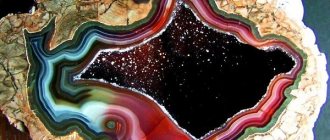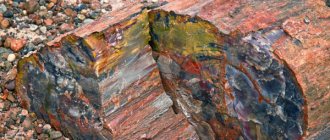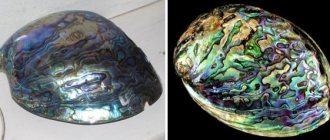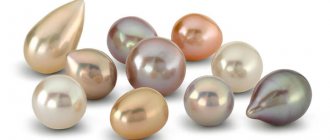Shrimp are seemingly well-studied creatures about which it is difficult to learn anything new. However, the discovery of a 100-million-year-old fossil has given scientists more food for thought. She showed that three shrimp about three centimeters long, possibly going on a hunt, chose a giant clam as a refuge far from coral reefs. Its width was about 25 centimeters. True, they still failed to escape in the shell of a mollusk - they were flooded with silt and mud as a result of a strong storm or earthquake. As a result, their temporary shelter became a grave for them, where they lay for many millions of years until 2016, when they were discovered by an Australian farmer. Now housed in an Australian museum, it serves as the oldest example of shrimp using another creature for shelter.
Scientists have discovered three shrimp hiding from danger in a fossilized shell of a mollusk.
History and origin
Ancient nautiluses are of great value to science. The stone, with the imprint of sea animals, tells a lot of things. With the help of fossils, scientists determine the geological age of a rock and track the biological evolution of all life on the planet.
Historically important are the finds of cephalopod fossils, which indicate that marine predators lived on the planet in the Paleozoic era, from the fourth to the last Cretaceous geological period. During one of the five great mass extinctions, cephalopods ceased to exist.
It is known that ammonites received their name in the 1st century AD thanks to the ancient Roman writer Pliny the Elder. The spiral-shaped shells of ancient organisms resemble the curled horns of a ram, which were possessed by the ancient Egyptian god named Amon, the lord and ruler of the black, heavenly space.
In the mid-18th century, the French biologist and naturalist Count de Buffon gave a detailed description of the fossils of marine organisms. At that time, one genus of ammonites was known, but today there are more than 3 thousand species. At that time, Europeans called fossilized shells “twisted stones.”
The beginning of the story.
The bright afternoon sun illuminates the silver-blue foaming crests of the waves of the Volga Sea.
Far on the horizon between the water surface and the sky there is a green strip of tropical vegetation - the shore of one of the islands. Winged, sharp-winged shadows fly over the waves with a sharp cry, snatching small fish from the water. And beneath the surface of the water, its own microscopic life is boiling. Single-celled algae absorb the rays of the sun and become food for the larvae of crustaceans and echinoderms, sea worms, small jellyfish and other creatures, big-eyed and translucent. Among these planktonic inhabitants there are tiny ball shells, about 1 mm in size, with thin, almost invisible tentacles. These are young ammonites, and today’s story will be about them.
Ammonites are distant relatives of nautiluses, the only modern cephalopods that have retained an external shell. Their history begins in the early Paleozoic. The first cephalopods had a compact, cone-shaped shell. Over time, the increase in the size of these animals created a serious problem. The straight, hard shell greatly reduced mobility, making the mollusks easy prey.
The slight curve of the shell gave an advantage in maneuverability and increased over time until a spiral was formed. Each curl of this spiral was adjacent to the next one, forming a solid structure. This design of the sink made it compact and manageable. This made it possible to lead an active lifestyle - to flee from predators and to hunt mobile prey. Thus, 410 million years ago, at the beginning of the Devonian period, a new subclass of cephalopods appeared - ammonites.
Place of Birth
Despite the fact that ammonites were marine animals, due to geological changes in the earth's thickness of the planet, the remains of mollusks are found on land, on almost every continent. Unique finds of fossil mollusks have been examined from dozens and even hundreds of deposits around the globe.
Precious shells are found in Morocco and the Republic of Madagascar. A jewelry ammonite was discovered in a deposit in Canada. In various regions of Russia, prospecting for fossils is underway. There are huge specimens, spirals reaching two or more meters.
Medicinal properties
If you put a large shell, such as rapan, against your ear, you can hear the sound of the sea surf. Many people know the sensations they get from listening; they remember the overwhelming peace and tranquility.
Also read: Azurite is a stone that charges you with optimism and relieves fears
Since ancient times, ancient healers have identified the valuable healing properties of ammonites. Prehistoric luminaries of medicine used shellfish fossils as a means of providing a sedative effect.
Each healing stone, fossils are no exception, has a beneficial effect on human health. Precious shells help heal:
- from nervous and mental disorders such as apathy, depression;
- sleep disorders, get rid of nightmares;
- from the problem of most modern people - “chronic fatigue”;
- slows down the aging process, helps preserve youth and beauty of skin and hair for longer;
- improves blood composition and restores blood circulation;
- strengthens the children's body, increases resistance to colds and helps cope with childhood illnesses.
Ancient Arab healers practiced treating infertility using crushed mollusk shells. It is known that any disturbances in the human energy field provoke the appearance of diseases. In the old days, Chinese healers claimed that ammonite affects the proper circulation of energy, which leads to the restoration and strengthening of the physical body.
Magic properties
Since ancient times, from the moment of origin, man has sought protection from Nature with the help of amulets. The modern rhythm of life has drawn people into a whirlpool of troubles, worries and “chaotic” movement; the human essence is weakening away from real natural resources that replenish the energy flow. That is why the use of a gem as a talisman is very popular among our contemporaries.
Natural stone is a battery that emits vibrations that strengthen the biofield. The magical ammonite stone contains the power and energy of ancient deep-sea creatures.
The stories of different nationalities talk about those features of shell amulets that are most acceptable to them. From all the beliefs, a general picture emerges about the magical power of the ammonite, and for what purpose they wear jewelry with the stone:
- Family happiness and well-being.
- Career growth, material well-being.
- Favors land and sea travel.
- Promotes careers such as explorers, archaeologists, sailors and submariners.
The energetic compatibility of a mineral with its owner helps to more clearly understand situations, anticipate and avoid danger. An amulet with a stone promotes the development of intuition.
Each nation had its own definition of the type of treasure. To some the stone looks like a snail, to others like a petrified snake. Some sources talk about the use of ammonite to communicate with otherworldly forces.
Important! It is not recommended to use gems for ritual actions that have a negative nature. It must be remembered that the mineral is a gift of nature, which gives it the ability to strengthen, and not destroy, the essence of a person.
The shell is both a house and a ship.
Several months have passed. Our ammonites grew up and left the surface layers of the water. Thousands of larvae were eaten by predators, but hundreds survived and now live on the coral reef, a barrier encircling the lagoon of one of the islands. Here, among the corals, submerged tree trunks, sponges and crinoids, there are many more hidden places - and more food for growing shellfish. Now their spiral shells have become stronger, and reach several centimeters in diameter.
The mollusk occupies the front part of the shell, expanding its edges and forming a partition behind itself. Partitions divide the interior space of the chamber into compartments. The edge of the septum where it connects with the wall of the shell has a complex curved structure. This is a lobate line; it forms a beautiful pattern on fossilized mollusk shells and serves as one of the main systematic features. A thin hollow tube permeated with blood vessels passes through all the partitions - a siphon. With its help, an ammonite can change its buoyancy, filling some of the compartments with carbon dioxide, and some with water.
Jewelry with mineral
High-quality jewelers create truly works of art from fossils. The decorations are unique, each in their own way; this is facilitated by the magnificent colors and bizarre shapes of the shells.
Also read: Amethyst - an ancient protector for a young family
Small sized clams are used for jewelry. The more colorful and pearlescent the surface of an ammonite, the higher its value. Approximate prices for fossils are provided:
- price for a polished ammonite from Madagascar, size 3x3.5 cm – $10;
- ammonite measuring 5x4 cm, mined in Saratov, costs $16;
- a polished fossil from Madagascar, measuring 5x6 cm, costs $25;
- a unique example of a polished ammonite cut, measuring 17x14 cm, brought from Madagascar, costs $280;
- polished cut from Karachay-Cherkessia, size 23x19 cm, costs $455;
- Ammonite from Morocco costs $20
Clam shell can be suitable for pendants, necklaces and other precious items. What color of metal the fossil goes with depends on the shade. To get an original piece of jewelry, you can buy a shell fragment and order an exclusive piece.
End of the road.
The life of cephalopods is rarely long. It lasts several years and ends with the most important event - reproduction. By the time they reach maturity, the behavior of ammonites changes. They form clusters, the males become aggressive and can damage the opponent’s shell with their sharp beak.
As soon as the choice of a partner is made, the pairs unite, intertwining their tentacles. Mating, similar to a strange dance, lasts more than a day. The male transfers the spermatophore to the female and dies from exhaustion.
After a few more weeks, the females will rise to the very surface to spawn and also finish their life journey. Millions of eggs will be released into free swimming so that young ammonites begin their lives among the plankton of the Volga Sea.
For 340 million years, ammonites lived in the seas. They participated in the formation of complex ecosystem connections of ancient communities. Many common species played key roles in the food chain, serving as both predators and prey. Their breeding strategy, with a short life cycle and millions of young, was effective. It allowed for rapid evolution, adapting to the environment and creating new species. But it also made ammonites vulnerable.
The fall of an asteroid at the boundary of the Cretaceous and Paleogene launched a chain of catastrophic changes that destroyed the ecosystems of the Mesozoic. A change in the acidity of sea water led to the death of plankton, and with it, juvenile ammonites. A short-term geological event turned out to be critical for these cephalopods and caused their complete extinction.
Today their shells are the pride of many museums and private collections. They help scientists look into the distant past of our planet and understand its history. And their living relatives (albeit very distant ones) - nautiluses - make us think about caring for the environment.
quick view add to cart
Ammolite ammonite Placenticeras costatum
Price on request
quick view add to cart
Ammolite ammonite Placenticeras costatum
Price on request
quick view add to cart
Ammonite Cleoniceras sp.
44 900 ₽
quick view add to cart
Variety
A whimsical curl of a shell, decorated with grooves, its smooth surface with a mother-of-pearl tint attracts the eye and makes you admire it. The colors of ammonites depend on the chemical elements that interacted with the shell surface.
It is known that removing the top scales of the shell reveals the bright, rich, iridescent colors of the precious fossil. For example, Ammolite is a type of ammonite that has a wide palette of colors; there are fragments that shimmer with all the colors of the rainbow.
A place under the sun.
Becoming stronger and more agile as they grow, ammonites move away from the reef wall towards the open sea. Forming large schools scattered throughout the water column, they follow sea currents, spreading over vast distances. They can compete with fish in numbers and diversity, and each species occupies its own ecological niche. Some ammonites hunt in the water column, relying on speed. Others stay close to the shore, protecting themselves from enemies with massive shells. Plankton catchers hover near the surface, spreading mucous membranes between their tentacles. Their shells do not look like regular spirals; they bend in different planes, giving the ammonite a bizarre appearance. Millions of years later, such ammonites would be called “heteromorphic.” The habitat of many species is located at different depths. Making daily migrations up and down, they seem to perform a complex dance, obeying their biological rhythms.
The diversity of ammonites led to the emergence of true giants. Most of these mollusks were, as usual, small - from 1-2 to 30 cm. Much fewer species had large shells with a diameter of about half a meter. But Parapuzosia seppenradensis stands out among them. This ammonite had a colossal shell - 2.5 meters in diameter. If you unfold it, the length of the shell will be more than 10 meters! The total weight of the giant reached 1.5 tons, of which the mollusk accounted for 700 kg.
Ammonites have complex eyes and good vision. Most of them live in the upper layers of water, where good vision plays an important role. Ammonite eyes are not preserved in the geological record. However, genetic studies of cephalopods suggest that they were no worse than those of squid and octopuses.
Another important sense is smell. Chemoreceptors of cephalopods are located on the tentacles. We can say that they both smell and taste using their hands. The ability to distinguish smells should have helped ammonites navigate the open sea and find food and a partner.
How to distinguish a fake?
Ammonite is unique and difficult to confuse with any other material. It will not be difficult to distinguish a natural sample from a fake if it is presented in full size. The situation is much more complicated with jewelry that contains precious varieties of shells in small fragments.
One of the characteristic features of a real ammonite is a non-repeating pattern. The fossil fragments in the earrings, absolutely identical in color and image, are most likely an imitation.
Caring for stone products
Ammonite jewelry is quite fragile, so it should be stored in a separate case with a soft velvet surface inside. Fossils, like pearls and amber, cannot withstand the effects of chemical reagents. Therefore, it is better to clean jewelry in a soap solution, which is thoroughly washed off with water.
Important! In order to preserve the beauty of an ancient treasure for as long as possible, it is necessary to protect it from high temperatures and direct sunlight.
Compatibility with names and zodiac signs
If you know about the impact of an amulet on a person’s energy, psyche and physical state, you can understand who is more suitable for a particular gem and who is less favored by its nature.
Also read: Carnelian - the meaning of the stone for a person
(“++” – the stone fits perfectly, “+” – can be worn, “-” – is strictly contraindicated):
| Zodiac sign | Compatibility |
| Aries | + |
| Taurus | + |
| Twins | + |
| Cancer | ++ |
| a lion | + |
| Virgo | + |
| Scales | + |
| Scorpion | ++ |
| Sagittarius | + |
| Capricorn | + |
| Aquarius | + |
| Fish | ++ |
The astrological properties of ammonite have a beneficial effect on every zodiac sign. However, clear patronage is given to representatives of the water element.
- Pisces are characterized by extrasensory abilities. An ammonite amulet promotes the discovery and development of extraordinary human characteristics.
- For Scorpios who have chosen a profession related to the sea, the talisman will protect them from troubles at work and protect them from financial losses.
- Cancer will receive the talisman’s support in creating favorable living conditions and will help strengthen family and friendly relationships.
The development of his personal qualities is important for a person. To do this, it is important to know about character traits. What quality does an ammonite amulet influence and strengthen if a person is named by one of these names:
- Agatha has a sense of humor and is characterized by logical thinking. The talisman promotes the development of these qualities.
- Anna is sincere, sensitive, proactive - these are the qualities that the amulet nourishes.
- Vera is reasonable, benevolent, balanced, and this is helped by the ammonite amulet.
- Evdokia is good-natured, sensitive and proud, but the jewel helps to harmonize these qualities.
- Rose is good-natured, open to communication and responsive, and the amulet helps protect her.
- Faina is impulsive, emotional and independent, but the talisman has a calming effect on a person.
Important! If you use a fossil as a talisman, you should know that the ammonite is “selfish” and does not accept proximity to other jewelry.
Living submarines.
More than a year has passed. Our ammonites lead a solitary, dangerous life on the open sea. Both predators and bad weather can cause their death. Fierce storms, turning the surface of the Volga Sea into a seething cauldron of foam, force cephalopods to plunge into the depths. Their shells are durable and can withstand high pressure thanks to the complex design of the paddle line. Here, in the darkness, at a depth of several hundred meters, flocks of belemnites glow with a cold light and the eyes of terrible ophthalmosaurs flash with pale saucers.
The soft, juicy meat of shellfish attracts many hunters. These include fish and marine reptiles, such as ichthyosaurs. When washed ashore by a storm, ammonites become easy prey for small dinosaurs and primitive mammals. But they themselves are formidable predators for those who are smaller in size. Fish, crustaceans, sea lilies and other sea inhabitants become their prey.
The musculature of ammonites was more complex than that of nautiluses. This is due to the high mobility of these mollusks. The hydrojet movement characteristic of cephalopods was carried out due to a strong, muscular funnel. And here a problem arises - if the mollusk does not somehow hold the shell, the impulse from the water thrown out by the funnel will simply press its body into the living chamber. On the penultimate whorl of the ammonite shell, the “black layer” is clearly visible. This is a rough area covered with melanin and other organic matter, which was used by the mollusk as a support. By clinging to it, the ammonite became, as it were, one with the shell and could control its movement.
Tentacles are the fishing tools for ammonites. Until there are clear imprints of soft tissues, it is difficult to judge their structure. But we can say with confidence that their original number was 10, like all cephalopods. Whether their number decreased, like in octopuses, or increased, like in nautiluses, is not yet known. No traces of chitinous hooks, like those of squid, were also found. But the presence of at least one pair of long hunting tentacles seems logical for active hunters, like ammonites.











